-
Countries
-
Data and Analysis
-
Special Focus
-
Crisis Responses
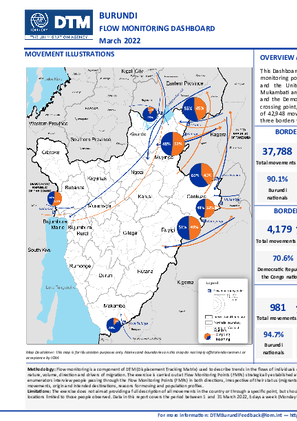
Contact
DTMBurundi@iom.int
Language
English
Location
Burundi
Period Covered
Mar 01 2022
Mar 31 2022
Activity
- Flow Monitoring Survey
- Flow Monitoring
This Dashboard provides an analysis of the trends in population mobility observed at eight (8) flow monitoring points (FMPs), six (6) established at unofficial border crossing points between Burundi and the United Republic of Tanzania border at Kabogo, Kwa Rutuku, Mbundi, Kabuyenge, Mukambati and Kwa Buhinja; one (1) established at official border crossing point, between Burundi and the Democratic Republic of the Congo at Gatumba and one (1) established at official border crossing point, between Burundi and Rwanda at Gasenyi-Nemba. Over the reporting period, a total of 42,948 movements were observed at these points. About 55 per cent of all movements at the three borders were incoming and 45 per cent were outgoing.

Contact
DTM Afghanistan, DTMKabul@iom.int
Language
English
Location
Afghanistan
Period Covered
Sep 01 2021
Nov 15 2021
Activity
- Event Tracking
The Displacement Tracking Matrix (DTM) Emergency Event Tracking (EET) is deployed by IOM in Afghanistan with the financial support of the European Union and the German Federal Foreign Office to track sudden internal displacement and population movements. Activated on a needs basis, the EET utilises a broad network of community focal points (CFPs) to capture best estimates of the affected population presence and immediate needs and vulnerabilities. One focal point is interviewed in each assessed community. This summary brief focuses on the coping mechanisms used in the assessed communities to address food shortages, as reported by the interviewed CFPs. In particular, the brief compares the rate of use of various types of coping mechanisms as reported by CFPs between Round 1 (1 September - 5 October 2021) and Round 2 (12 October - 15 November 2021) of the EET. The EET reports can be found here (Round 1 and Round 2)

Contact
DTM Peru, IOMDTMPeru@iom.int
Language
English
Location
Peru
Period Covered
Mar 01 2022
Mar 31 2022
Activity
- Flow Monitoring
El 14 de febrero de 2022 se dio la reapertura de fronteras con presencia militar en el puente internacional Perú-Ecuador, después de dos años de permanecer cerrado debido a la pandemia. Sin embargo, se ha observado que persiste la entrada de personas refugiadas y migrantes venezolanas al país a través de puntos no oficiales. Estas entradas se registran con mayor frecuencia antes de las 8am y después de las 5pm que el pase por el puente se cierra. En ese sentido, a fin de caracterizar a la población en movilidad humana por la frontera norte, OIM ha desplegado la herramienta DTM para realizar encuestas a la población objetivo para conocer las características de las personas beneficiarias de asistencia humanitaria.

Contact
DTM Nigeria, AllUsersInDTMNigeria@iom.int
Language
English
Location
Nigeria
Period Covered
Mar 01 2022
Mar 31 2022
Activity
- Other
In Nigeria, the conflict between farmers and herders, which emanate from competing claims to natural resources is compounded as a result of factors such as population growth, expanding human settlements, land privatization, year-round farming, environmental degradation, weakened traditional conflict resolving mechanism and climate change. The Transhumance Tracking Tool (TTT) collects key data on transhumance in Adamawa state, with the aim of providing information related to the internal and cross-border movements along the official and unofficial corridors.
The TTT Early Warning identifies pattern of alerts related to the use of natural resources, agro-pastoral practices and herders’ movements that is linked to events or massive/unexpected movement of livestock that could cause a conflict. It also helps understand the modes of resolution of conflicts and inform the competent authorities in order to reduce tensions or prevent conflict. A network of Key informants selected from members of the Community Response Network (CRN) and LGA-based team leads were used for data collection.
During the month of March 2022, the TTT Early Warning tool captured 262 alerts. The triangulated alerts include 218 (83%) events and 44 (17%) massive/sudden movements. The event alerts spread across 79 per cent of the wards in the 5 operational LGAs. Kodomti and Borrong wards located in Numan and Demsa LGAs respectively, share the highest number of recorded event alerts. This was primarily attributed to early or late passage of pastoral groups, damage in surrounding fields by pastoral groups, non-use of official transhumance corridors and competition around animal resources. Furthermore, key informants indicated that several localities outside of the TTT's operational areas, which frequently are subject to tensions between herders and farmers, might witness incidents, including Hong, Jada, Shelleng and Yola North LGAs. These presents an important early warning opportunity of monitoring events that are related to early or massive movements of transhumance and to mitigate potential farmers-herders’ conflicts in these locations.
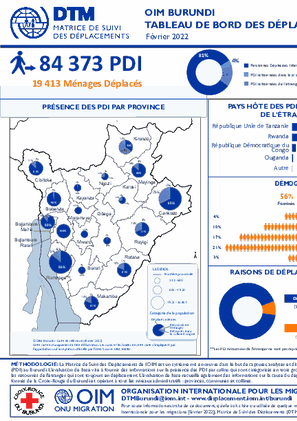
Contact
DTM Burundi, DTMBurundi@iom.int
Language
English
Location
Burundi
Period Covered
Feb 01 2022
Feb 28 2022
Activity
- Mobility Tracking
- Baseline Assessment
La DTM a identifié 84 373 personnes déplacées internes (PDI) réparties dans 19 413 ménages déplacés, 92% des déplacements étaient dus à des catastrophes naturelles et 8% à d'autres raisons.

Contact
DTM Sudan; dtmsudan@iom.int
Language
English
Location
Sudan
Period Covered
Apr 14 2022
Apr 12 2022
Activity
- Event Tracking
- Mobility Tracking
The DTM Emergency Event Tracking (EET) is deployed to track sudden displacement and population movements, provide more frequent updates on the scale of displacement, and quantify the affected population when needed. As a subcomponent of the new Mobility Tracking methodology in Sudan (Round Three), and activated on a need basis, EET utilises a broad network of key informants to capture best estimates of the affected population presence per location – a useful tool for humanitarian response planning and design.
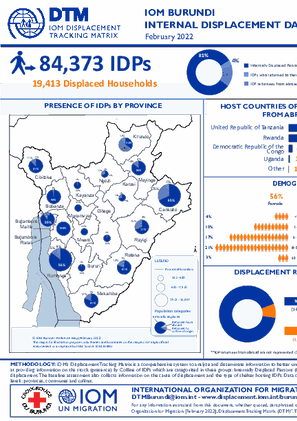
Contact
DTM Burundi, DTMBurundi@iom.int
Language
English
Location
Burundi
Period Covered
Feb 01 2022
Feb 28 2022
Activity
- Mobility Tracking
- Baseline Assessment
DTM has identified 84,373 internally displaced persons (IDPs) in 19,413 households, 92% of the displacement were due to natural disasters and 8% other reasons in the month of February 2022 covering all 18 provinces of Burundi.
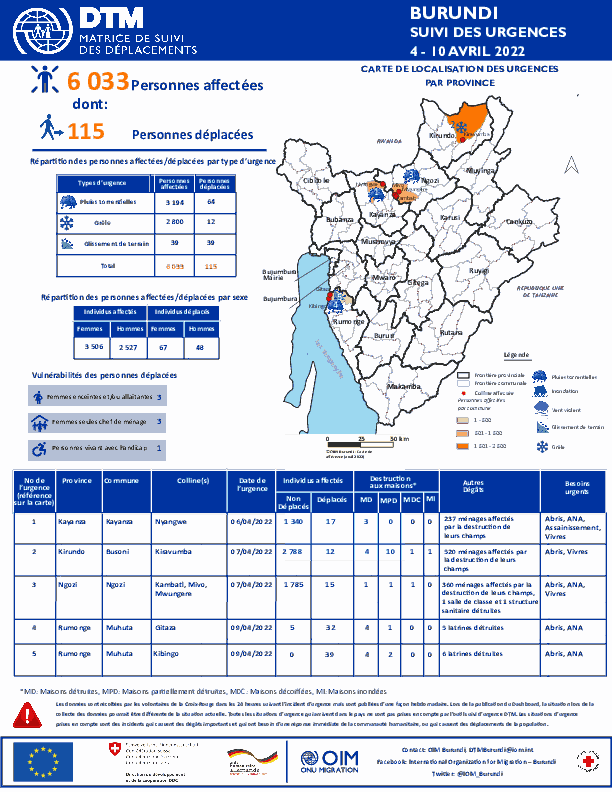
Contact
DTM Burundi, DTMBurundi@iom.int
Language
English
Location
Burundi
Period Covered
Apr 04 2022
Apr 10 2022
Activity
- Event Tracking
- Mobility Tracking
Entre le 4 Avril et le 10 Avril 2022, la DTM a identifié 6 033 personnes affectées, dont 115 personnes déplacées, par les pluies torrentielles, grêle, et glissement de terrain dans les provinces de Kayanza, Kirundo, Ngozi et Rumonge.
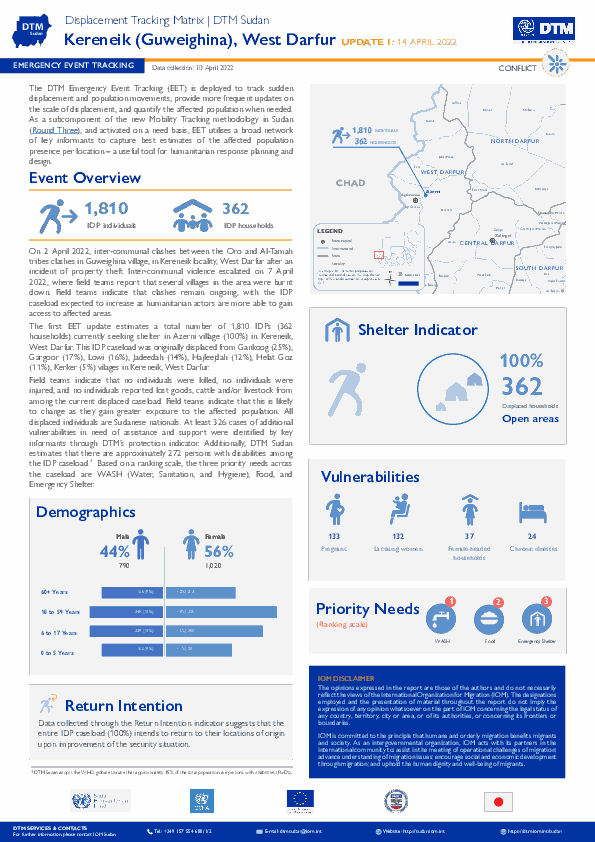
Contact
DTM Sudan; dtmsudan@iom.int
Language
English
Location
Sudan
Period Covered
Apr 10 2022
Apr 14 2022
Activity
- Event Tracking
The DTM Emergency Event Tracking (EET) is deployed to track sudden displacement and population movements, provide more frequent updates on the scale of displacement, and quantify the affected population when needed. As a subcomponent of the new Mobility Tracking methodology in Sudan (Round Three), and activated on a need basis, EET utilises a broad network of key informants to capture best estimates of the affected population presence per location – a useful tool for humanitarian response planning and design.
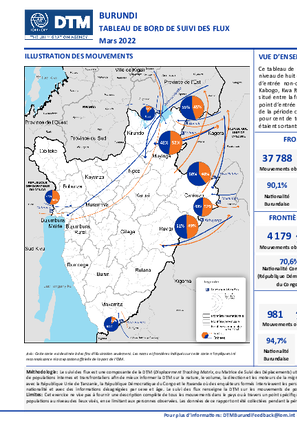
Contact
DTMBurundi@iom.int
Language
English
Location
Burundi
Period Covered
Mar 01 2022
Mar 31 2022
Activity
- Flow Monitoring Survey
- Flow Monitoring
Ce tableau de bord fournit une analyse des tendances de la mobilité des populations observées au niveau de huit (8) points de suivi des flux (Flow Monitoring Points, FMP), six (6) établis sur des points d’entrée non-officiels établis entre la frontière du Burundi et la République Unie de Tanzanie à Kabogo, Kwa Rutuku, Mbundi, Kabuyenge, Mukambati et Kwa Buhinja; un (1) point d’entrée officiel situé entre la frontière du Burundi et de la République Démocratique du Congo à Gatumba et un (1) point d’entrée officiel situé entre la frontière du Burundi et du Rwanda à Gasenyi-Nemba. Au cours de la période considérée, un total de 42 948 mouvements ont été observés à ces points. Environ 55 pour cent de tous les mouvements au niveau des trois frontières étaient entrants et 45 pour cent étaient sortants.
